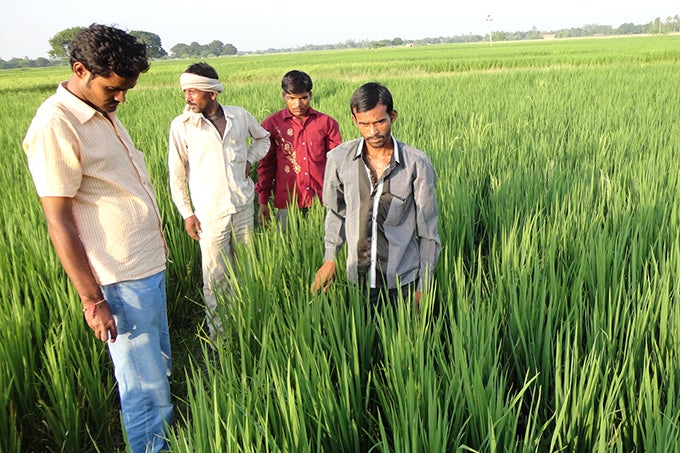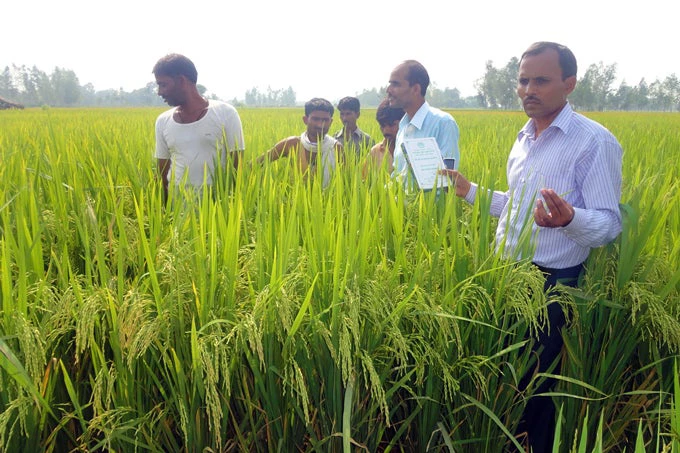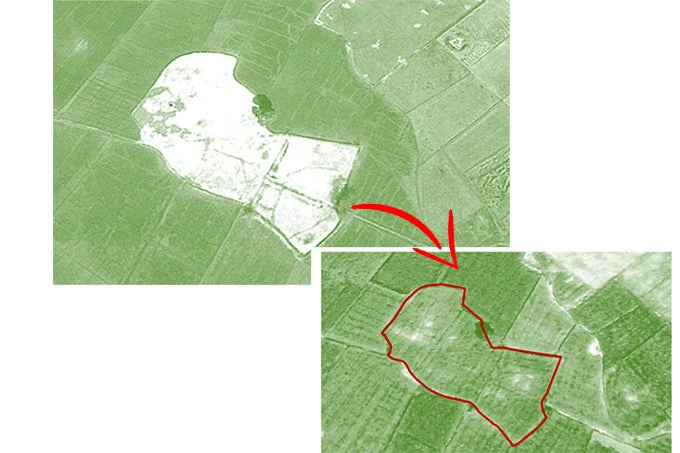
About 15 minutes after we turn off the highway at Fatehpur, a roadside trading center located 120 km from Lucknow, the capital of Uttar Pradesh, a mild haze blankets the sky.
As we drive deeper into the increasingly bare and desolate landscape, the wind blows stronger, and the haze thickens into dust plumes.
I lower the car window and find the source of the dust: patches of abandoned land, coated with very fine powder in various shades of white and grey.
We are in a village with salt-affected soils, part of the millions of hectares of India’s wastelands.
Characterized by dense, impermeable surface crusts and accumulation of certain elements at levels that are toxic to plants, these sodic wastelands no longer support crop growth – they have been abandoned by farmers.
Our journey continues for another 30 minutes, the wind still blows strong, but dust plumes have given way to clearer skies.
We have reached Mainpuri, where, with World Bank support, sodic wastelands have been reclaimed and brought back to life, rolling back the unsavory spectacle of ecological destruction that once was the hallmark of the village.
Now in its third phase, the Uttar Pradesh Sodic Lands Reclamation Project (UPSLRP) has supported the reclamation of over 400,000 ha of such sodic wastelands and 25,000 ha of ravinous wasteland .

“Before the project, nothing could grow on this plot; crops and grasses used not to germinate or would just burn away,” says Lalit, a farmer.
About 54 percent of the wasteland reclaimed under the UPSLRP is producing a crop for the first time, including 3.5 tons of paddy per hectare and 3.3 tons of wheat per hectare, amounts statistically at par with yields obtained on un-degraded land in the project area.
The total incremental crop production under the third phase project stands at 383,600 tons of rice and 350,900 tons of wheat.
Vegetables, oilseeds, and pulses are now also produced as part of the new management protocol for the reclaimed land, which emphasizes a cereal to non-cereal rotation.
All this from what was hitherto abandoned wasteland. This incremental food production is yet another addition to India’s expanding food supply.
While India now produces sufficient amounts of food to meet its requirements, climate change has emerged as a serious threat to the country’s food security.
If business were to continue as usual, it is projected that by 2040, India might experience a more than 25 percent reduction in crop production because of climate change.
Both the Bank’s and Government’s strategies in support of adaptation to climate change have mainly focused on scaling up climate smart agriculture and risk insurance.
This strategy, if pursued alone, could easily come up short in ensuring adequate adaptation in India - a country recently ranked the most vulnerable to climate change.
How about a more deliberate focus on reclaiming and bringing into production some of India’s wastelands to partially offset some of the projected crop production declines expected because of climate change?

Fairly simple technology options already exist to reclaim at least 50 percent of these wastelands to make them cultivable, like in Mainpuri.
However, going to scale will require progress on many complementary fronts, including but not limited to:
- Understanding the interaction between wastelands up for reclamation and climate change: By default, wasteland reclamation would create a new ecosystem. On one hand, it is possible to spend resources to reclaim land, only to have that land/ecosystem become either technically, or economically unsuitable for production in the future due to a changing climate. On the other hand, reclamation would alter the land surface which in turn influences the energy and material exchange between the reclaimed land and atmosphere as well as the biogeochemical cycle. Depending on scale this could exert an influence on climate. In this case, comprehensive climate modeling and landscape studies would be useful to inform decisions on which wastelands, if reclaimed, would not only remain productive under a changing climate, but also not exert negative influences on climate;
- Strengthening knowledge services: Farm models based on reclaimed wastelands are bound to be knowledge-intensive as they require greater management of a wider range of factors. The most successful and sustainable interventions are likely to be those that build capacity, strengthen and improve producers’ access to appropriate knowledge services and products. This will require further strengthening of the increasingly weak advisory services in India;
- Strengthening policies to promote improved and sustainable management of reclaimed land: Favorable policies, including those on land rights and tenure, input and output marketing/pricing, extension, etc., are needed to foster proper management of reclaimed wastelands and support the long-term sustainability of reclamation outcomes. In recent years, India has made commendable progress in strengthening the policy environment for improved land management. However, some gaps remain, for example, with respect to land markets, women’s rights to land and input and output pricing. Closing these gaps should go a long way in ensuring that reclaimed lands would be sustainably managed; and
- Better understanding of the cost, economic feasibility and “competitiveness” of reclamation: The cost and feasibility of wasteland reclamation can vary considerably depending on the type of wasteland, degree of degradation, location, climate and availability of relevant expertise. All other factors being equal, assessment of the feasibility of restoration can inform decisions on selection and prioritization from among the many wastelands. Such an understanding is also important to assess the “economic competitiveness” of reclamation efforts compared to other alternatives to securing food security e.g. relying on imports from other countries.
Addressing the threat will entail thinking outside the box, which could include focusing on wasteland reclamation to offset anticipated crop production losses.
Besides augmenting production, investments in wasteland reclamation can also help restore ecosystem services such as climate regulation and aesthetics, and also increase biodiversity.


Join the Conversation